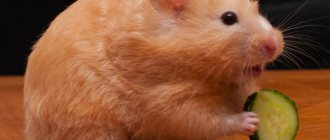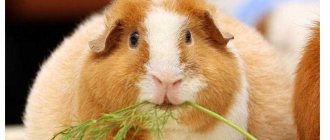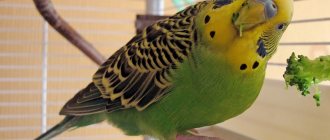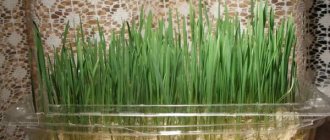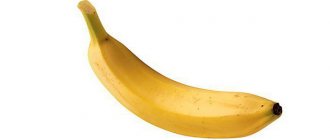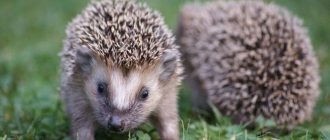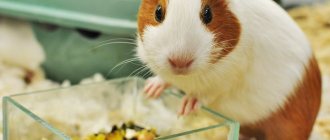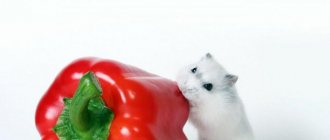With the arrival of summer, more seasonal products appear on our table: different varieties of berries, fresh home-grown vegetables, juicy greens straight from the garden. All of them contain a huge amount of useful substances and microelements. When we consume summer gifts for food, we often think about treating our pets to them. Hamsters, like other rodents, benefit from greens. Therefore, let’s consider whether hamsters can have parsley and dill, and how to serve them correctly.
Composition of parsley
Parsley is a very unpretentious plant, so it can grow in almost any soil. In most countries it is a popular addition to the main dish.
Contains many useful elements:
- B vitamins;
- ascorbic acid;
- folic acid;
- niacin;
- phosphorus;
- sodium;
- calcium and many others.
All these positive qualities have a positive effect on the connective tissues of the body, relieving symptoms of intoxication, and maintaining water-salt balance in the body.
There are two types of parsley: curly and ordinary, but both are equally useful.
Will any variety work?
You can experiment and grow different varieties of dill for your hamster. But if this is not possible, but you have a dacha or your own garden, then ordinary dill, which grows in almost every garden, is quite suitable for additional complementary feeding.
If the pet owner does not have a summer cottage, then such greens can be grown without problems at home, for example, on a windowsill, or periodically bought in supermarkets.
Parsley in a hamster's diet
To ensure that all the necessary vitamins are regularly present in the animal’s body, it is necessary to give it greens. Parsley is one of the first candidates to be added to the main diet. It will not only replenish vitamins in the animal’s body, but will also have a positive effect on its digestive organs. In addition, there are special elite foods that consist of a special number of nutrients specifically for hamsters. And their contents definitely include parsley and dill.
Little ones are practically not allergic to such a product, so you can give them parsley without fear. You need to collect good greens; those growing near roadways are not suitable. Before use, you need to wash it well, without separating it from the stem, since all the components of parsley are equally useful.
The benefits of grass for a hamster
These rodents are very fond of fresh greens, so they must be present in the diet of Djungarian, Syrian and other breeds of hamsters. You should give as many permitted types of herbs as possible because they contain a different set of vitamins. Greens are a good source of energy for animals due to their carbohydrate and protein content.
Important! Domestic rodents are prohibited from feeding grass collected on the street, near highways or near industrial areas. Such greenery is contaminated with dust, soot, heavy metals and other harmful substances.
The beneficial properties of the herb include:
- the presence of vitamins, namely groups A, B, C and E, helps improve the animals’ resistance to various diseases;
- a large amount of useful microelements such as calcium, magnesium, iron, phosphorus, zinc, potassium;
- fiber supports the animal’s digestive system and helps process food;
- some types of herbs can serve as medicines for the prevention and treatment of diseases, for example, plantain has a disinfecting effect, and knotweed has a diuretic and anti-inflammatory effect;
- individuals of small species build houses or nests for babies from grass.
Your hamster should always have enough fresh greens in his cage. However, it is important to pay attention to its varieties and give only healthy and high-quality food, so as not to harm the health of the animal.
Composition of dill
Dill is a short-lived plant, but it is a valuable product for health benefits and goes well with main dishes on the human table. All its parts have healing properties: leaves, stems and fruits (seeds). It is unpretentious to the soil, so it grows on almost all continents.
Dill is rich in the following elements:
- B vitamins;
- other vitamins: C, E, P;
- essential oil;
- organic acids;
- magnesium;
- phosphorus;
- iron and many others.
Dill improves immunity, has a beneficial effect on the cardiovascular system, and improves the functioning of the gastrointestinal tract.
How to give correctly?
Hamsters need to be pampered with fresh herbs not only in the summer. Green treats should be available in your pet's feeder all year round. In summer and autumn, the rodent’s body should receive up to 300 grams of fresh greens per day. A young individual will need 100 grams, but older rodents will need twice as much.
The main thing to remember is that there should be moderation in everything, and you should treat your pet with dill no more than two or three times a week, then he will be healthy, cheerful and full of energy.
If the animal happily eats various greens, then you can include in its diet not only dill, but also other healthy foods - parsley, fresh lettuce or spinach. But it is not recommended to give sorrel, green onions, mint and basil to rodents, since these greens contain harmful elements for the animals’ bodies.
If you find an error, please select a piece of text and press Ctrl+Enter.
Other greens
If we consider other options for juicy, healthy greens for the Djungarians or Syrians, then the following options are suitable:
- Lettuce leaves are a favorite delicacy for hamsters; before eating, you need to wash the leaves well and renew the stem by cutting just above the end of the stem.
- Spinach will be useful for rodents with constipation; it has a beneficial effect on the digestive system.
But these plants should never be given to a hamster:
- Green onions contain a lot of sugar, which leads to obesity.
- Sorrel – Oxalic acid causes heartburn and bloating. Due to unpleasant sensations in the tummy, the animal may behave aggressively.
- Mint - the menthol contained in its composition irritates the walls of the stomach. May cause ulcers.
- Basil – contains an increased amount of essential oils, which will not benefit the home.
- Mushrooms - in any form are contraindicated for furry rodents; eating them can be fatal.
Herb for newborns
It is recommended to introduce grass into the diet of newborn hamsters when they reach the age of one month, but not earlier. By this time, the stomach will have become stronger and will begin to function normally, and the animal will be able to eat the main food on its own. Greens should be given in small portions, and preference should be given to soft varieties. It is recommended to first observe how willingly a small rodent eats herbs and periodically change their types.
Did you know? The smallest rodents are considered to be Roborovsky's hamsters, which were discovered in 1894 in the Tien Shan. They reach a length of only 5–6 cm and are distributed throughout the world.
List of do's and don'ts
The list of foods that will negatively affect your rodent's health is not so small. It is worth remembering it, or better yet, writing it down, so that you never make a mistake when giving another treat to your hamster. So, hamsters should not eat foods such as:
- Cheese (in any form of any kind);
- Food for other animals (parrots, birds and other rodents);
- Potatoes (in any form);
- Persimmon (a variety that knits);
- Acorns;
- Drops for rodents;
- White and black bread;
- Crispbread (spicy with seasonings);
- Brazilian nut;
- Salt;
- Sugar;
- Spices (any);
- Butter;
- Citrus;
- Almond;
- Muesli and breakfast cereals;
- Onions (leeks and onions);
- Garlic;
- Bones (cherry or apricot);
- Potato peel;
- Cabbage (white and red);
- Sausages (any);
- Milk (cow and goat in any form);
- Sour cream;
- Cream;
- Exotic fruits and aphrodisiacs (kiwi, pineapple, pomegranate, avocado);
- Fried and fatty foods;
- Pasta (dry);
- Watermelon;
- Sorrel;
- Kozinaki;
- Mushrooms;
- Honey;
- Coniferous branches (pine, spruce, spruce, larch, etc.);
- Fruit juices;
- Mint;
- Tulip;
- Insects (caught from nature);
- Greens (picked within the city or near roads);
- Figs;
- Ice cream;
- Chocolate;
- Cookies (any other sweets).
Now, knowing exactly what you can feed your hamster, you can properly organize its nutrition and keep it healthy. Remember that proper care of your pet, even such a small one, will give you and him many years of joy.
Best regards, Evgeniy.
www.domotvetov.ru
Let's sum it up
Can hamsters have parsley and dill? Certainly. But it is advisable that the greens come from your garden. Purchased in a store, it can be treated with chemicals, pesticides, and nitrates. Most of the harmful substances are found in the stems, so if it is not possible to grow plants yourself, feed the hamster only leaves, after soaking them in water for an hour - this will help rid the greens of excess chemicals.
Finally, a little advice: be sure to put dill and parsley for your hamster in a plate, otherwise the playful animal will simply scatter it around the cage and trample it.
Tama the Cat: Train Station Master
This happened in the early 2000s, when the unprofitable Kishi station in the Japanese city of Kinokawa was almost closed due to unprofitability.
Residents, of course, protested, but it is unlikely that their efforts would ultimately be crowned with success. The situation was saved by a local cat named Tama, who loved to bask in the sun near the train station. The station manager noticed how enthusiastically passengers reacted to this couch potato and gave him the official position of caretaker. The cat was given a uniform cap, a badge and a monthly salary in the form of free food. The duties of the newly minted minister included advertising functions. He greeted passengers, allowed himself to be petted, and was always somewhere on the platform. It must be said that this policy very quickly led to commercial success. Tourists began to come to Kishi station just to look at the railway cat and take pictures with him. From that moment on, there was no further talk about closing the station.
But the unusual cat's career did not end there. In 2008, Tama became a supervisor and was charged with monitoring the performance of professional duties by staff. That same year, the cat was knighted. Another year later, according to the project of the famous designer Eiji Mituku, the railway included in the schedule a train dedicated to the legendary animal. The carriages were painted with views of Tama, the locomotive was decorated with his muzzle, and meowing signaled the opening (closing) of the doors. But this did not become the crown of the cat’s career.
A year later, Tamu was appointed third party of the railway company, entrusted with the post of executive director. By his old age, it was already difficult for him to work every day, and the management allowed the elderly cat to come to work 3 days a week.
Tama died at the ripe old age of 14. But even after this, the career did not end. Posthumously, the cat was elevated to the rank of Eternal Station Master, thus perpetuating his memory. After all, over the years of work, this four-legged employee has brought considerable income to his company. The tourist flow through the station increased to 300 thousand people annually, and the financial indicator amounted to more than 1.1 billion Japanese yen.
The company's management did not want to accept the loss of such a profitable and already promoted advertising brand. Tama was replaced by Nitama (the second Tama). True, later with the third cat there was an overlay. He was found at Okayama Station and offered a position in Kishi. But the owner did not agree to the move. Next came Yontama (the fourth Tama), who had already had to undergo a special training course before taking her place on the platform of the railway station.
And the flow of tourists wanting to take a photo with the legendary heirs of the first Tama still does not dry out.
I like2I don't like
What kind of grass can you give to your pet?
For consumption, the animal can be given any herb that is suitable for humans in its raw form. But it is worth remembering that the animal is unlikely to like onions, but the hamster will not refuse salad. Greens from the street can only be given if they are collected away from highways and busy traffic.
Clover, burdock (young shoots), and wormwood grass in moderate doses are suitable for rodent food. It is also worth remembering a number of the following points:
- Wheatgrass is considered a common plant. It can also be seen in hay intended for rodents. A moderate amount of wheatgrass will benefit the rodent.
- Knotweed is often used in folk medicine. This medicinal herb is also safe for rodents.
- As for dandelion, your hamster can only eat the leafy part of the plant. But you need to feed it to the animal carefully. If there is too much dandelion, it can harm the rodent's gastrointestinal tract. It is necessary to introduce dandelion into your hamster's diet only after consulting a veterinarian.
- Plantain, in addition to knotweed, is also recommended for hamsters in unlimited quantities.
- Another herb that has high nutritional value is nettle. This plant is useful for rodents as a means of preventing vitamin deficiency. In early spring, the animal is allowed to give nettle leaves. But before that, they should be boiled to remove the acid. Then squeeze, cut and give to your pet.
Prohibited Products
Not all grass is healthy
Along with the recommended plants, there are those that can cause harm to the hamster. Which ones exactly and what are the dangers of using them?
- Sorrel, despite the vitamins it contains, can cause allergies or irritation of the mucous membranes in a rodent.
- Cabbage will make the fragile animal swell.
- Potato tops and sprouts are poisonous to hamsters.
- Not only do garlic and onions have a pungent odor, they also provoke allergic reactions in many rodents. Mint and lemon balm are prohibited for the same reason.
It is strictly forbidden for hamsters to pick greens in public places. Such vegetation is teeming with infections and can be poisonous.
Features of feeding a pregnant or lactating woman
While bearing and feeding offspring, the female Syrian hamster needs to eat heavily. During this crucial period, she requires a slightly larger amount of nutrients. A complex of vitamin and mineral supplements should also be introduced. The diet includes more fresh greens, sprouted grains and high-protein foods. Food should be as varied as possible and definitely healthy.
Veterinarians advise putting a mineral pebble (sold at any veterinary pharmacy), a piece of chalk, coal or calcium gluconate inside the cage as a treat. A pregnant or lactating female hamster usually has an increased appetite and she usually becomes very anxious when food is scarce. To avoid negative consequences for her and her offspring, it is recommended to increase the amount of feed given. It is better if there is always food in the bowl, but it must be fresh.
What to feed small hamsters
For the first four weeks of their lives, small hamsters feed exclusively on their mother's milk. There is no need to feed them additionally. Newborn hamsters left without a mother (or in the absence of milk from her) are fed with soy-based infant formula for the smallest (from birth 0+). You can also feed it with a cat milk replacer.
Once they reach the age of one month, they begin to be offered other food. The digestive system of babies is still very delicate, so the diet of adult hamsters is not suitable for them.
Regular grain food is poured into a bowl so that the kids can rummage through it and choose what they like. It is better not to give nuts, fruits and other treats for now, but to put them aside for later (until he grows up). Hamsters should be fed milk formula and porridge; you can mix steamed oatmeal or buckwheat flakes with baby puree (from various vegetables or meat). Gradually, one by one, other products are introduced: sprouted grains and young shoots, fresh herbs.

